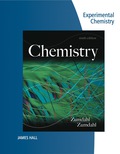
(a)
Interpretation: The ion or molecule, having iodine as the central atom, that is isoelectronic with each of the given compounds is to be stated.
Concept introduction: Two compounds are said to be isoelectronic if they contains same number of valence electrons.
Total number of valence electrons in a compound is equal to the sum of valence electrons present in each atom of that compound.
To determine: The ion or molecule, having iodine as the central atom, that is isoelectronic with each of the given compounds.
(a)
Explanation of Solution
The compound
The molecule xenon tetroxide
An ion
Since
(b)
Interpretation: The ion or molecule, having iodine as the central atom, that is isoelectronic with each of the given compounds is to be stated.
Concept introduction: Two compounds are said to be isoelectronic if they contains same number of valence electrons.
Total number of valence electrons in a compound is equal to the sum of valence electrons present in each atom of that compound.
To determine: The ion or molecule, having iodine as the central atom, that is isoelectronic with each of the given compounds.
(b)
Explanation of Solution
The compound
The molecule xenon tetroxide
An ion
Since
(c)
Interpretation: The ion or molecule, having iodine as the central atom, that is isoelectronic with each of the given compounds is to be stated.
Concept introduction: Two compounds are said to be isoelectronic if they contains same number of valence electrons.
Total number of valence electrons in a compound is equal to the sum of valence electrons present in each atom of that compound.
To determine: The ion or molecule, having iodine as the central atom, that is isoelectronic with each of the given compounds.
(c)
Explanation of Solution
The compound
The molecule xenon difluoride
An ion
Since
(d)
Interpretation: The ion or molecule, having iodine as the central atom, that is isoelectronic with each of the given compounds is to be stated.
Concept introduction: Two compounds are said to be isoelectronic if they contains same number of valence electrons.
Total number of valence electrons in a compound is equal to the sum of valence electrons present in each atom of that compound.
To determine: An ion or molecule in which iodine is the central atom and that is isoelectronic with xenon tetrafluoride.
(d)
Explanation of Solution
The compound
The molecule xenon tetrafluoride
An ion
Since
(e)
Interpretation: The ion or molecule, having iodine as the central atom, that is isoelectronic with each of the given compounds is to be stated.
Concept introduction: Two compounds are said to be isoelectronic if they contains same number of valence electrons.
Total number of valence electrons in a compound is equal to the sum of valence electrons present in each atom of that compound.
To determine: An ion or molecule in which iodine is the central atom and that is isoelectronic with xenon hexafluoride.
(e)
Explanation of Solution
The compound
The molecule xenon hexafluoride
An ion
Since
Want to see more full solutions like this?
Chapter 20 Solutions
Lab Manual For Zumdahl/zumdahl's Chemistry, 9th
- One liter of chlorine gas at 1 atm and 298 K reacts completely with 1.00 L of nitrogen gas and 2.00 L of oxygen gas at the same temperature and pressure. A single gaseous product is formed, which fills a 2.00 L flask at 1.00 atm and 298 K. Use this information to determine the following characteristics of the product:(a) its empirical formula;(b) its molecular formula;(c) the most favorable Lewis formula based on formal charge arguments (the central atom is N);(d) the shape of the molecule.arrow_forwardHow does the square root mean square velocity of gas molecules vary with temperature? Illustrate this relationship by plotting the square root mean square velocity of N2 molecules as a function of temperature from T=100 K to T=300 K.arrow_forwardDraw product B, indicating what type of reaction occurs. F3C CF3 NH2 Me O .N. + B OMearrow_forward
- Benzimidazole E. State its formula. sState the differences in the formula with other benzimidazoles.arrow_forwardDraw product A, indicating what type of reaction occurs. F3C CN CF3 K2CO3, DMSO, H₂O2 Aarrow_forward19) Which metal is most commonly used in galvanization to protect steel structures from oxidation? Lead a. b. Tin C. Nickel d. Zinc 20) The following molecule is an example of a: R₁ R2- -N-R3 a. Secondary amine b. Secondary amide c. Tertiary amine d. Tertiary amidearrow_forward
- pls helparrow_forwardpls helparrow_forward35) Complete the following equation by drawing the line the structure of the products that are formed. Please note that in some cases more than one product is possible. You must draw all possible products to recive full marks! a. ethanol + 2-propanol + H2SO4 → b. OH conc. H2SO4 CH2 H3C CH + K2Cr2O7 C. d. H3C A pressure CH3 + H2 CH Pt catalystarrow_forward
 ChemistryChemistryISBN:9781305957404Author:Steven S. Zumdahl, Susan A. Zumdahl, Donald J. DeCostePublisher:Cengage Learning
ChemistryChemistryISBN:9781305957404Author:Steven S. Zumdahl, Susan A. Zumdahl, Donald J. DeCostePublisher:Cengage Learning Chemistry: An Atoms First ApproachChemistryISBN:9781305079243Author:Steven S. Zumdahl, Susan A. ZumdahlPublisher:Cengage Learning
Chemistry: An Atoms First ApproachChemistryISBN:9781305079243Author:Steven S. Zumdahl, Susan A. ZumdahlPublisher:Cengage Learning
 Chemistry: The Molecular ScienceChemistryISBN:9781285199047Author:John W. Moore, Conrad L. StanitskiPublisher:Cengage Learning
Chemistry: The Molecular ScienceChemistryISBN:9781285199047Author:John W. Moore, Conrad L. StanitskiPublisher:Cengage Learning General Chemistry - Standalone book (MindTap Cour...ChemistryISBN:9781305580343Author:Steven D. Gammon, Ebbing, Darrell Ebbing, Steven D., Darrell; Gammon, Darrell Ebbing; Steven D. Gammon, Darrell D.; Gammon, Ebbing; Steven D. Gammon; DarrellPublisher:Cengage Learning
General Chemistry - Standalone book (MindTap Cour...ChemistryISBN:9781305580343Author:Steven D. Gammon, Ebbing, Darrell Ebbing, Steven D., Darrell; Gammon, Darrell Ebbing; Steven D. Gammon, Darrell D.; Gammon, Ebbing; Steven D. Gammon; DarrellPublisher:Cengage Learning Chemistry & Chemical ReactivityChemistryISBN:9781337399074Author:John C. Kotz, Paul M. Treichel, John Townsend, David TreichelPublisher:Cengage Learning
Chemistry & Chemical ReactivityChemistryISBN:9781337399074Author:John C. Kotz, Paul M. Treichel, John Townsend, David TreichelPublisher:Cengage Learning





